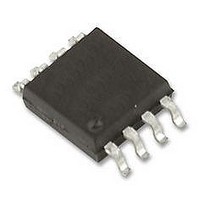LT1999MPMS8-50#TRPBF Linear Technology, LT1999MPMS8-50#TRPBF Datasheet - Page 17

LT1999MPMS8-50#TRPBF
Manufacturer Part Number
LT1999MPMS8-50#TRPBF
Description
SC-Amps/Current Sense, High Voltage, Bidirectional Current Sense Amplifier
Manufacturer
Linear Technology
Datasheet
1.LT1999MPMS8-10PBF.pdf
(24 pages)
Specifications of LT1999MPMS8-50#TRPBF
Input Bias Current
137.5µA
Output Current Per Channel
26mA
Input Offset Voltage
1.5mV
Bandwidth
1.2MHz
Cmrr
120dB
Slew Rate
3V/µs
Supply Voltage Range
4.5V To 5.5V
Supply Current
3µA
Rohs Compliant
Yes
No. Of Amplifiers
2
Available stocks
Company
Part Number
Manufacturer
Quantity
Price
APPLICATIONS INFORMATION
The REF pin should be either driven by a low source im-
pedance (<100Ω) or should be bypassed with at least 1nF
to a low impedance, low noise, signal ground plane (see
Figure 4). Larger bypass capacitors on both V
the REF pin, will extend enhanced AC CMRR, and PSRR
performance to lower frequencies. Bypassing the REF pin
to a quiet ground plane fi lters the V
that is sensed by the REF pin voltage divider and applied
to the noninverting input of output amplifi er A
mon I•R drops generated by pulsating ground currents in
common with the REF pin fi lter capacitor can compromise
the fi ltering performance and should be avoided.
If the SHDN pin is not driven and is left fl oating, routing
a PCB trace connecting Pins 1 and 8 under the part will
act as a shield, and will help limit edge coupling from the
inputs (Pins 2 and 3) to the SHDN pin. Periodic pulses on
the inputs with fast edges may glitch the high impedance
SHDN pin, periodically putting the part into low power
shutdown. Additional precaution against this may be taken
by adding an optional small (~10pF) capacitor may be tied
between V
Finally, when connecting the LT1999 inputs to the sense
resistor, it is important to use good Kelvin sensing practices
(sensing the resistor in a way that excludes PCB trace
I•R voltage drops). For sense resistors less than 1Ω, one
might consider using a 4-wire sense resistor to sense the
resistive element accurately.
+
(Pin 1) and Pin 8.
+
pin or GND pin noise
O
+
. Any com-
pins, and
Selection of the Current Sense Resistor
The external sense resistor selection presents a delicate
trade-off between power dissipation in the resistor and
current measurement accuracy.
In high current applications, the user may want to mini-
mize the power dissipated in the sense resistor. The sense
resistor current will create heat and voltage loss, degrading
effi ciency. As a result, the sense resistor should be as small
as possible while still providing adequate dynamic range
required by the measurement. The dynamic range is the
ratio between the maximum accurately produced signal
generated by the voltage across the sense resistor, and
the minimum accurately reproduced signal. The minimum
accurately reproduced signal is primarily dictated by the
voltage offset of the LT1999. The maximum accurately
reproduced signal is dictated by the output swing of the
LT1999.
Thus the dynamic range for the LT1999 can be thought of
the maximum sense voltage divided by the input referred
voltage offset or:
The above equation tells us that the dynamic range is
inversely proportional to the gain of the LT1999. Thus,
if accuracy is of greater importance than effi ciency or
power loss, the LT1999-10 used with the highest valued
sense resistor possible is recommended. If effi ciency,
heat generated, and power loss in the resistive shunt is
the primary concern, the LT1999-50 and the lowest value
sense resistor possible is recommended. The LT1999-20
is available for applications somewhere in between these
two extremes.
Dynamic Range =
LT1999-10/LT1999-20/
∆V
GAIN • V
OUT(MAX)
OSI
LT1999-50
17
1999fa














